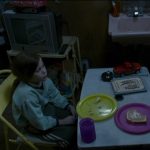Room – 2015
This was a movie that I wasn’t too sure about. I watched it and found myself wondering why it had been nominated for Best Picture. On the surface, there didn’t seem to be a good reason. It had a plot that reminded me of a Lifetime Movie-Of-The-Week. But the fact is, it stuck with me, and had me thinking about it for a while after the credits were done rolling. Not only have I been considering the story structure, but also the cast, the acting, the set design, the social significance, and the film’s emotional resonance. Because, really, it had all those things.
The movie had a very simple plot that can be summed up pretty quickly. A young girl is abducted when she is seventeen by a man who locks her in a shed and habitually rapes her. After two years, she gives birth to a son who lives in captivity with her. When the boy is five, the girl devises a plan to escape, which is successful. The girl rejoins society, and the boy, who barely believes that a world exists outside the shed, must learn to live in his new environment. Both the girl and her son have severe psychological and emotional difficulties to overcome. But in the end, human beings are highly adaptable, and the two learn to rebuild their lives in the wake of the horrible tragedy.
First of all, I have to comment on the social relevance of the movie. It came out in 2015, and I am put in mind of the horrific 2013 story of Ariel Castro and his abduction of three women whom he beat and raped for up to eleven years. And that is just one of many similar stories that I was able to easily find on the internet. It is sick and tragic, but it is also an unfortunate sign of the times. This kind of thing actually happens. Socially significant? You better believe it.
Actress Brie Larson played the victim, Joy Newsome, referred to in the credits as Ma. Her son Jack, played by child actor Jacob Tremblay, is the biological offspring of the perpetrator, known as Old Nick, played by Sean Bridgers. Ma and her son are imprisoned in a backyard shed, that has become their entire existence. In severe contrast to the real Castro case, Ma and Jack are furnished with the basics of living. In their tiny shed, they have a working toilet, a stove, dishes, a table, chairs, a bed, a bathtub, clothing, and most of the comforts of a normal life. They seem to have everything except freedom. Jack has a number of toys, and they even have a television.
While watching the film, I thought this was pretty horrible. But after reading about the Castro case, I can see how this film REALLY softened the narrative. In other words, compared to the real victims I have mentioned, Ma and Jack were living in the lap of luxury. This isn’t a problem with the film, but someone watching Room should know that their lives could have been a hundred times worse. They could have been chained to the walls like animals, left alone in a dark room, beaten and raped on a regular basis, fed once a day, and allowed to bathe a few times a week… for over eleven years.
The first half of the movie chronicled their captivity. It is Jack’s lack of experience that makes most of it interesting. He doesn’t believe that there is anything beyond the door. He doesn’t understand that the images on the TV are of real things. He doesn’t know the difference between the reality of live actors and cartoons. Life inside the tiny room is all he knows. And he doesn’t believe Ma when she tries to explain these things to him.
But eventually, Ma conceives of a daring escape plan, one that, with a lot of luck, sounds like it might work in a real life situation. Ma tricks Old Nick into taking Jack out of the shed, where he is able to get help. Old Nick is arrested and Ma is rescued. The second half of the movie follows Ma and Jack as they begin to recover and rejoin the world. Ma returns to her parents, who have gotten a divorce. Joan Allen played her mother, Nancy, and William H. Macy played her father, Robert. Returning to the house in which she was raised, Ma meets her mother’s partner Leo, played by Tom McCamus. The heart-wrenching story of the aftermath of their ordeal was well-handled. The point is also made that yes, Ma was the victim, but hers was not the only life that was damaged by her disappearance. Her parents were both devastated as well. Fortunately, in the end, the movie makes the point that even in these kinds of extreme circumstances, healing is possible.
Larson did a fantastic job in her role. She played the average, ordinary girl in a frighteningly real, and all too believable situation. Understandably, she took home the Oscar for Best Actress for the part. She really turned in a great performance in both halves of the movie. Tremblay also did a pretty good job, and I liked both Allen and Macy as well. And I also have to give special props to Lenny Abrahamson for his sensitive direction, and Ethan Tobman for his smart and detail oriented set design. But all that being said, should it have been nominated for Best Picture? Honestly, I don’t know. Maybe. I’m on the fence about this one. Yes, it was good, but it still felt a little too much like a made for TV Lifetime Movie-Of-The-Week.








